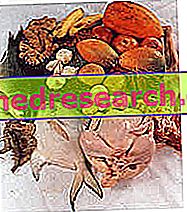See also: Milk delattosate Lactose and Intolerance Lactose-free milk is mainly used to feed people who are intolerant to milk and in particular to its sugar, called lactose. Nutritionally speaking, lactose is a disaccharide formed by the union of glucose (the main sugar of the human body) and galactose (a monosaccharide essential for the formation of nervous structures in children)
Category food intolerance
Definition Gluten intolerance is a paraphysiological condition of altered intestinal tolerance towards a protein nutrient, called gluten . In Italy, permanent gluten intolerance is known as celiac disease or celiac disease, while in English it is labeled with many other names, such as: c (o) eliac sprue , c (o) eliac disease, nontropical sprue , endemic sprue and gluten enteropathy
What is favism? Favism is a genetic anomaly that affects some enzymes contained in red blood cells. Known since ancient times as a "bean disease", this disease, as can be seen from the word itself, entails the absolute necessity to avoid the intake of fava beans and other foods, such as peas and verbena, some drugs and particular substances
What are Biogenic amines are nitrogen compounds produced by microbial decarboxylation of amino acids. Since these microorganisms are commonly present in the environment, biogenic amines can be contained in foods and beverages . Their concentration is greater in fast perishable foods, especially if fermented and rich in particular amino acids, such as fish, meats, meats, fruit juices, wine, cocoa, dairy products and cheeses
What are Food colors are substances that have no nutritional value, or are used for non-nutritive purposes, added during the processing of food products to give them particular chromatic characteristics or enhance their original color, thus giving them an inviting and more appealing appearance. The use of food dyes, therefore, aims essentially to increase consumer interest and appreciation of the products to which they are added
Lactose is the problem of intolerance Lactose intolerance is a condition in which the consumption of milk and dairy products causes a non-allergic reaction that manifests itself with gastrointestinal disorders such as bloating, cramps and occasional diarrhea. The fault is attributable to the lack or reduction of enzymes responsible for the digestion of lactose, ie the sugar contained in milk and its derivatives
See also: Milk delattosate Lactose and Intolerance Lactose-free milk is mainly used to feed people who are intolerant to milk and in particular to its sugar, called lactose. Nutritionally speaking, lactose is a disaccharide formed by the union of glucose (the main sugar of the human body) and galactose (a monosaccharide essential for the formation of nervous structures in children)
What is Celiac Disease? Celiac disease, also called celiac sprue or gluten enteropathy , is a disease that affects the intestine as the main organ, but which has many important consequences even at a distance, and which depends on an alteration of the immune response by the lymphocytes T of people genetically predisposed against gluten, which is a substance normally ingested in the diet
Generality What are sulphites and why are they used? Sulfur dioxide (E220) and sulphites (from E221 to E228) are used in the food industry as antimicrobial, anti-enzyme and antioxidant preservatives. As such, they are used to inactivate molds, yeasts and bacteria, as well as to preserve the color of foods and protect them from browning
Related articles: Favismo Definition Favism is the consequence of a gene defect that reduces the concentration of some enzymes essential for the good functionality of red blood cells. Within the erythrocytes of subjects affected by favism, therefore, there is a shortage of the aforementioned enzymes - called glucose-6-phosphate-dehydrogenase (G6PD), essential for metabolizing glucose, the energy fuel of erythrocytes
Related articles: Food intolerances Definition Food intolerance is an adverse reaction of the body to certain foods. Unlike what happens in food allergies, this reaction does not depend on the abnormal activation of the immune system with its antibodies; moreover, it is less severe, occurs gradually and is proportional to the amount of food that is ingested (almost as if the organism is "poisoned")










